Friday, September 20thWe dedicated our first day to an one-day cruise to The Great Barrier Reef. Our main destination was the coral island of Michaelmas Cay. It was a reserve where nest by hundreds Brown Noddys and the Sooty Terns. On the boat, we met a couple of English birders with a young child. we get on well together. The crossing was very quiet in fact not to say disappointing: very little bird on sea: few Great Crested-Terns, some Brown Boobies and several squadrons of Pied Imperial-Pigeon (a white and black pigeon). The main attraction will be in fact a group of Bottlenosed Dolphin which came a moment to swim to the bow of the ship. The spectacle really began when we were close to the island. As we arrived, 5 Great Frigatebird flew above the island before disappearing. The boat was fastened to a fixed anchor, then a dinghy brought us on the island. a small space was reserved for the tourists. That allowed to see birds closely. Terns and especially Noddys were very confident and let come nearer without fear. After I took pictures of terns, we looked for Black Noddy without success but we added to our list Eastern Reef-Egret and Ruddy Turnstone. Equiped myself with mask, snorkel and palm and I plunged to discover the reef. What most amazed me it was the number of species of Parrotfish : I did not think that they had so much! A little farther we made a second dive. We also saw Common Tern and a very pale Tern that we did not identify... In the evening, we had a dinner at the harbour with the couple of English birders. We decided to met Steve at the Esplanade early in the morning tomorrow . Saturday, September 21stThe Cairns Esplanade was well known for waders. Indeed there was a big mud area in ebb tide which allowed many birds to feed. Of course, we saw plenty of new birds: Great Knot, Curlew Sandpiper, Sharp-tailed Sandpiper, Grey-tailed Tattler, Pacific Golden-Plover, Terek Sandpiper, Mongolian Plover, etc... After one or two hours of observations we left this place for the "Cairns Botanic Gardens". This garden was famous for birds: rightly! A small path crossed a remainder of forest which leads to a small zone of lawn in border of a mangrove swamp. A little farther, there's a fresh water lake and a salt water lake: a lot of variety in the landscapes and consequently a great bio-diversity. At the beginning, we saw Australian Brush-turkey which crossed the path just in front of us. A little farther, we observed at leisure Spectacled Monarch, Black Butcherbird, Brown-backed Honeyeater, Yellow Honeyeater, Helmeted Friarbird... The fresh water pond was the most interesting place: for exemple, we saw Nankeen Night-Heron and in the sky two Brahminy Kite. Just after Steve's departure, we saw a magnificent Yellow-bellied Sunbird and two Nutmeg Mannikin. Valérie found a nest of Willie-wagtail. We also made our first observations of Swiftlet without being able to identify them: we laernt later that it was White-rumped Swiftlet: it was the only one visible in september. After lunch we went to Daintree River. On the way, we stop 2 hours to visit the "Tjapukai Aboriginal Cultural Park". This park is quite at the same moment a museum, a theater and a place of exchange which allowed the aboriginal tribe of the region (the Tjapukai) to present their cultures, their faiths and their history. To join Daintree the road followed the coast before turning off to the northeast. We ended the day with a very beautiful observation of Rufous Fantail and of first sihgt of the "famous" Laughing Kookaburra. Sunday, September 22ndWe decided to go to Daintree on the advices of the Dutch and the English met since the beginning of our trip. All of them said that the boat cruise with Chris Dahlberg was really fine and that's right !it began at 6:30 AM. It was probably the most famous place to see the Little Kingfisher in Australia but we had already seen it at Kakadu N.P. Seen the behavior of an English next to me, he seemed really come for this bird! We returned twice to the small cove where it usually stayed. As the guide put back full gas, I perceived the bird which arised on a dead branch: I have make a happy man! Of course there was plenty of other attractive species: Blue-winged Kookaburra, Sacred Kingfisher, Common Koel, Channel-billed Cuckoo and Little Bronze-Cuckoo. We saw our first Papuan Frogmouth on nest over the water: don't miss the pictures ! For an other good photo, see the Welcome Swallow. The cruise ended at 8:30 AM. Our breakfast waited for us in the lodge and we had only few hundred of meters to walk from the pier. It took us more than one hours! The main responsible was a Pacific Baza which landed just over my head in a tree. I even had to put off to photograph it! At the end of the morning, we took advantage of the swimming pool and birds around us like Laughing Kookaburra which particulary like sausages... After that, we set off in the direction of Kingfisher Park: it was renowned lodge and campsite for ornithologist in the heart of the Atherton Tableband area. On the road we made a beautiful observation of Black-shouldered Kite. We arrived at the end of afternoon. We settled our tent before making a small walk arrounds. Some seeds were put down by the owner near rooms attract new species for us: Red-Browed Finch, Gray-headed Robin, Emerald Dove, Macleay's Honeyeater. A little farther, we discovered a colony of Metallic Starling. At sunset, we made our first attempt of observation the Platypus: first defeat. We only saw White-tailed Rat... We had a dinner with a couple of French met this afternoon. At night we found a beautifull green Frog in the showers. We finished this day by a small walk with spotlight: we saw some flyin-foxes and two Bandicoots. Monday, September 23rdYesterday evening, a local guide recommended us to make a walk to Mount Lewis. On the road, a river was a very good site to see the Platypus. Farther, after a path about 1 kilometer there's a small pond infested by Red Billed Black Snake: the third snake most poisonous of Australia but also one of the quietest.... With the french couple we met in the campsite, we stopped on the bridge which overhanged the small river: no Platypus. However, as we arrived a big brown bird of prey flew away: probably a Red Goshawk ! Unfortunatly our sight was too short for identifying it.... All the same, this place allowed us to observe a half-dozen of Lovely Fairywren and our first Silvereye. Then, we retook the car to join the path to the pond. When we arrived in the forest, the place was at once interesting. Barely gone down from car, we saw a White-cheeked Honeyeater and an Eastern Spinebill. The diversity of birds was very important on the path: Wompoo Fruit-Dove, Barred Cuckoo-shrike, Topknot Pigeon, Chowchilla, Yellow-throated Scrubwren, Brown Cuckoo-Dove... At the pond we found rapidly a beautiful specimen of Red Billed Black Snake probably sloughing. The animal was indeed very quiet but we stayed at a reasonable distance! A little farther, a Grey Fantail was very trusting with photographer. La balade ayant durée plus longtemps que prévue (comme d'habitude...), nous quittons rapidement nos compagnons de route pour reprendre la voiture en direction de la "Cassowary House" : un autre Lodge très réputé pour les oiseaux. Nous nous arrêtons tout de même à nouveau sur la rivière mais toujours sans succès. Toutefois un joli serpent bleu et blanc est bien visible juste à ma hauteur dans les roseaux. As usual, the stroll had lasted much longer that foreseen and we were obliged to quickly leave our fellow travellers and to take the car to the direction of the Cassowary House: another lodge very renowned for birds. We stopped again on the river but always unsuccessfully. However, a beautiful blue and white snake was visible in the reeds. Good spots did not miss on the road even if the Atherton Tableband is strongly transformed by the agriculture. We lunched on a track which separated the lake Mitchell in two. This place was very abundant with birds of water: Balbuzard, Cotton Pygmy-goose, Sarus Crane, Australian Wood Duck, Black-necked Stork, Black Swan and fully others ducks and waders. We also saw few passerine like Red-backed Fairywren or and Grey-crowned Babbler. At the end of afternoon, we took a track to Emerald Creek. A stop in a crossing allowed us to admire two Pale-headed Rosella. We arrived at Emerald Creek before the sunset. That was another place which might be nice to investigate... At last, we were late for the dinner who was foreseen. A river crossed the property and before sleeping we tried to observe the platypus: unsuccessfully again... Tuesday, September 24thWe raised at 6:30 am for trying to see the Platypus always without success... My wife returned to bed whereas I investigated neighborhood on foot. That was a good idea because I saw a Victoria's Riflebird, a Pied Monarch and a light yellow Robin. just before arrivin to a bridge, I met a couple of tourist who had just observed the Platypus few minute later! It's too late for me.... I returned to the lodge to awake my wife for the breakfast. We took it on the terrace on the first floor. We are surrounded by a multitude of birds which came to look for the various food available for them: Macleay's Honeyeater, Silvereye, Helmeted Friarbird and even Spotted Catbird and Victoria's Riflebird! On the ground the competition is rough between Australian Brush-turkey and numerous different mammals: three rodents species and one Musky Rat-Kangaroo, the ancestor of the Kangaroo. We discussed a moment with the owner and when she learnt that we had not seen the Red-necked Crake yet, she disappeared one moment. She reappeared at the ground level with a piece of cheese and then shout "CHEEEESE". Few seconds later the Crake came! We left the lodge in the middle of the morning with a sight of a new species: a Scarlet Myzomela. We made a small walk in the forest close to the house. This site was well-known for the Southern Cassowary. We had a little of hope when we heard some noise inthe Subwood: it was about two wild dogs ( maybe Dingoes?) which appeared unless about fifty meters of us. They disappeared before I had the time to take my camera... We drove to Cairns where we lunched at the end of the Esplanade. We found some waders but nothing new with regard to the first time. Our plane was at the end of afternoon. We made a small visit of the mangrove which was situated just before the airport. A path built on piles allowed to discover this environment in good condition. We caught only a glimpse of one bird: probably a Collared Kingfisher... We arrived at the beginning of the evening to Sydney. We reserved since the airport a Bungalow in a Caravan Park near Sydney. |
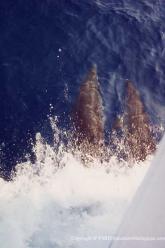 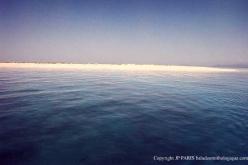 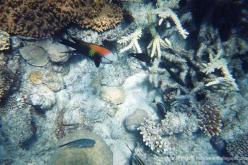 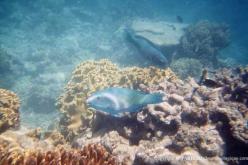  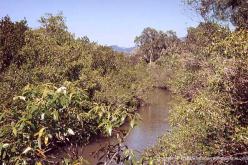 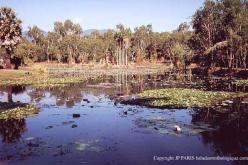 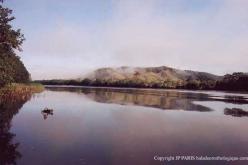 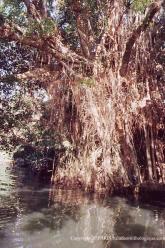 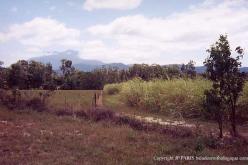  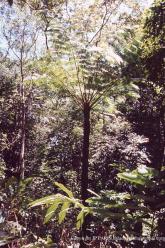  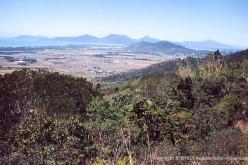  |